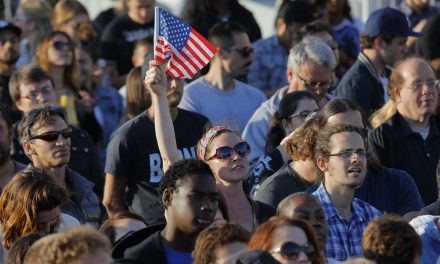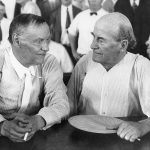
NextGen believes its multi-million dollar effort helped increase turnout among voters ages 18-35, but experts say that cannot be tied to one group or strategy.
Borna Riazi, 19, said his parents and teachers “never really” pushed him to vote. Riazi did not see voting as something that had a direct impact on his life. Plus, he described himself as “too lazy.”
“I wish you could just show up to a place and just vote,” Riazi said. “Like, no pre-registration, no nothing.”
But being a student on the University of Wisconsin-Madison campus before the 2018 midterm elections put voting directly in Riazi’s path. After “annoying” appeals from fellow UW student Eric Schumacher, he finally gave in and registered.
“I wasn’t about to go out of my way, and then they were doing voter registration at the gym,” Riazi said. “I basically live there. … So I was like, ‘Well, I guess I better register.’ ”
Then about a week before the midterm elections, Riazi, Schumacher and their friend Lee Conway walked by a giant giraffe bounce house on the campus of 44,000 students. Field organizers from NextGen Wisconsin, a political action group focused on turning out young progressive voters, encouraged them to enjoy the free bounce house and to vote early. The three jumped for about 20 minutes, then walked across the street to cast their ballots.
For Riazi, NextGen Wisconsin definitely played a role in getting him to vote — a tough job since young people like Riazi show up less than any other age group, especially during midterms. The stakes are high: By 2020, millennials and Generation Zers together are projected to make up 36 percent of the electorate — more than Baby Boomers at 28 percent, according to Pew Research.
Connie Flanagan, associate dean of the UW-Madison School of Human Ecology and an expert on youth and politics, said people tend to start caring more about politics after finishing their education, getting a job and starting a family — milestones that millennials and Gen Zers are hitting at later ages than previous generations.
According to estimates provided by NextGen, the number of 18-35-year-olds who voted in Wisconsin increased from 232,095 in 2014 to 313,197 in 2018 — an increase of more than 80,000. Governor Tony Evers won the gubernatorial election by 29,227 votes. With young people ages 18-29 supporting Evers by a 60-37 margin over incumbent Gov. Scott Walker based on CNN exit polls, it is clear that new young voters helped to push Evers to his narrow victory.
A NextGen America spokeswoman said her group was the largest in Wisconsin working to turn out young people, although experts caution that without more research, the increase cannot be definitely tied to one group or strategy.
“We believe we have the most staff, the most money invested, the most states, the highest number of total registered voters,” said Olivia Bercow, deputy communications director for NextGen America. “We’re the largest youth vote program in American history.”
Voting brings youth issues to forefront
When young people do vote, politicians take up the issues they care about, Flanagan said. Because of youth involvement in the 2016 presidential primary — particularly Vermont Democrat Sen. Bernie Sanders’ campaign — issues including the rising cost of college and a $15 minimum wage are “getting attention now.” High youth turnout in the 2018 midterms kept those issues in the forefront, she said.
Young people are often ignored by get-out-the-vote efforts because they are unlikely to turn out and lack a voting history. NextGen America, funded by billionaire activist Tom Steyer, pumped $33 million into 11 states, including Wisconsin, targeted specifically at getting young progressives to the polls for the 2018 midterms. Steyer also leads a national campaign advocating the impeachment of President Donald Trump. The group’s get-out-the-vote effort in Wisconsin cost nearly $3 million.
“We invest in youth organizing kind of in an unprecedented way,” said Sean Manning, former Wisconsin media manager for NextGen America, who was on the ground for the 2018 midterms.
NextGen used strategies including puppies, goats, rallies and celebrities to get young voters to the polls. And it may have worked. But whether such an effort is sustainable election after election and in settings outside college campuses remain open questions, experts told the Wisconsin Center for Investigative Journalism. Civic education in high school, automatic voter registration, pre-registration for teenagers and removing barriers to register and vote also may be ways to boost the youth vote, they said.
Youth voting up in 2018
Young voter turnout in 2018 was the highest for a midterm election in 25 years, according to exit poll calculations by the Center for Information and Research on Civic Learning and Engagement, or CIRCLE, a research organization based at Tufts University that focuses on young people.
Roughly 31 percent of 18-29-year-olds turned out nationally for the 2018 midterms, up from 21 percent in 2014, according to CIRCLE. But even with these “extraordinary” increases for a midterm, the vast majority of young people nationwide — 69 percent — still did not vote. The youth rate was higher in five states with competitive gubernatorial races. Wisconsin, Florida, Georgia, Nevada and Ohio had a combined average youth turnout rate of 35 percent.
Still, those numbers lagged behind the roughly 50 percent of eligible U.S. voters who cast ballots in the midterms. Wisconsin’s turnout was 61.7 percent, according to the United States Election Project, based at the University of Florida, which tracks voter turnout. Four experts interviewed by the Center said a long-term solution for getting more young people to the polls involves a lot more than one mobilization effort — even one that has millions of dollars behind it.
“If you ask me, ‘How can we have a solution that raises turnout by like 30 percentage points in one cycle?’ I don’t think we have one,” CIRCLE Director Kei Kawashima-Ginsberg said. “It’s really just not that easy, I’m sorry to say.”
Goats for votes
NextGen’s efforts in Wisconsin included door knocking, digital advertising, direct mail and a variety of events designed to connect with young people. The group had 66 staff and 1,756 volunteers on the ground at 32 college campuses across Wisconsin, including four-year universities and several community colleges.
At UW-Stevens Point, NextGen hosted a petting zoo with goats, alpacas, ducks and cows. At UW-Madison, celebrities led two canvassing events. At UW-Green Bay, NextGen held a carnival. Organizers used other tactics ranging from therapy dogs to giant Connect Four games to get young people engaged. At some get-out-the-vote events, organizers wore shark, T-rex and banana costumes as they gathered pledges to vote.
“We’re turning voting into this fun, exciting thing,” Manning said. “It’s not that it has to be that way, it’s just, why can’t it be?”
The group also held rallies calling for increased gun control and opposing forced separation of undocumented immigrant families. NextGen sent nearly 530,000 texts, knocked on nearly 180,000 doors and reached more than 580,000 young voters with digital advertising on platforms including Hulu, YouTube and Instagram. Riazi remembers seeing NextGen’s advertisements — and although they were “ruining his life” because he could not skip to the video he wanted to watch — the ads worked.
“Obama is like, ‘Your generation, right now, has more power, than’ — and I’m like, ‘Oh my god,’ ” Riazi said. “‘I will vote. Okay? Chill.’”
NextGen Wisconsin also got nearly 51,000 young people to sign pledges to vote. The group matched at least 40 percent of those names to the list of registered voters. Bercow said incomplete or out-of-date addresses likely led to fewer matches, but also some who pledged did not register. Of those matched, 65 percent voted.
‘Impossible to say’ what drove increases
Unless the pledges were selected randomly, the statistic may not be representative of all young voters, said David Becker, executive director and founder of the Center for Election Innovation & Research, a nonprofit that works with election officials on issues including increasing voter participation. NextGen focused much of the pledging on college campuses, where young people are more engaged politically, and therefore already more likely to vote.
For instance, Frances Bartolutti, a sophomore at Loyola University-Chicago who is from Madison, filled out a pledge card with NextGen at an August anti-National Rifle Association march in Madison, and she voted during the 2018 midterms. But Bartolutti, 19, was already planning to vote. She has voted in every election since turning 18, even sending in an absentee ballot for Madison’s February mayoral primary.
“Growing up, my parents emphasized that you have a voice and you should execute it,” Bartolutti said. NextGen also targeted youth in Wisconsin who were unlikely to vote.
The group sent mail to more than 166,000 young people ages 18-35 who were either unlikely voters — meaning they never voted before or only voted once — or sporadic voters, who voted only a few times but not consistently. NextGen could match about half of those voters with the voter file; of those, 60 percent voted in 2018.
Turnout among younger voters increased even in states where NextGen was not operating. So far, CIRCLE has released state-by-state voter turnout data for 17 states. Of the four with the highest increases in voter turnout — Georgia, Montana, Minnesota and Nevada — NextGen had a presence only in Nevada. Becker said one major factor driving people to the polls in 2018 was opposition to Trump. Kawashima-Ginsberg said another factor was competitive races in many states, places where Becker noted that media coverage and campaign spending are higher.
Positive media coverage of young people, especially of student-led activism following the school shooting in Parkland, Florida, also helped, Kawashima-Ginsberg said. Before the midterms, CIRCLE found that 80 percent of 18-24-year-olds thought their generation could make a significant change in the United States.
Abby Kiesa, director of impact at CIRCLE, said there also was lots of peer-to-peer outreach in 2018, something research has consistently found boosts young people’s political engagement. Kiesa said media coverage and young people encouraging their peers to vote combined to “shift the culture” around the 2018 midterms. The increases in youth turnout could be due to any of these influences, Becker said. NextGen may have had a positive effect, but it is “impossible to say” without more data, he said.
Bercow said NextGen is still excited with what it accomplished, even if the group can only show correlation, not causation. NextGen has kept staff in all 11 of its states and will be organizing through the 2020 election. Bercow said Steyer is committed to turning out the youth vote, even if there is not a specific dollar amount of what he will invest in the future. Becker, however, wonders what will happen in 2022 and beyond.
“There’s no way to fund an effort to hold the hand of the 200-plus million eligible voters in the United States for every single election,” Becker said. “It’s just not feasible.”
Getting outside the college bubble
Even after investing more than $30 million, there were young people NextGen did not reach. NextGen focuses on college campuses because the target demographic is concentrated in one area, Bercow said, but “we’re always looking for ways to expand it.” NextGen also knocked on doors and sent mail to neighborhoods of predominantly young people outside of college campuses and ran digital advertisements throughout the state.
“That is our biggest challenge, reaching young people who don’t live on a four-year college campus, and even reaching young people who don’t go to community college,” Bercow said. “But we are trying to use every resource, every tactic in the book, to do so.”
For those in a college town, messaging about voting was hard to avoid. Brody Bien, a junior studying molecular biology at UW-Madison, said canvassers frequently knocked on his door, sometimes two or three times a day. Bien said they were “pushy and annoying,” especially since Bien was already planning to vote.
“If you look at young people who are the most privileged and affluent, like young college graduates who make really good salaries, turnout is incredibly high already,” Kawashima-Ginsberg from CIRCLE said. “The problem is the gap. And the reason why it’s so hard to address these gaps is because it’s deeply embedded in our general social inequalities.”
As Bien and Riazi were bombarded with voter mobilization messaging at UW-Madison, Chander Brown, a 20-year-old who lives just a half hour south of the Madison campus, was not contacted by anyone. Brown, who went to Madison West High School, now works for a cleaning company and lives with his parents in Stoughton, Wisconsin.
When asked if any of the get-out-the-vote efforts in Madison reached him, Brown said, “I don’t know what that is, honestly.” Brown deleted most of his social media accounts, so he is a particularly hard young person to contact. In high school, Brown felt like his vote would not count for anything. Brown’s mindset started to change because of his frustration with Trump. Brown’s father is very passionate about politics. Both factors caused him to “mature” and pay greater attention to the 2018 midterms — even without the urging of NextGen or a political campaign.
“What mostly motivates me (to vote) is just for a change,” Brown said. “I would hope that something could change and that I didn’t just sit back and do nothing.”
‘A vote’s not gonna change nothing’
Jacob Hoskins Jr., 17, has a deep skepticism toward politicians and the government. He is a student in the Legacy Program at Operation Fresh Start, a Madison nonprofit that helps young people ages 16-24 finish their education and gain work experience. Hoskins is working on his high school diploma and developing skills to pursue a career in construction.
When he went to Madison East High School, he said, teachers would tell students to vote, “But we didn’t ever learn about it.” His mom has told him to vote, but it is not a conversation they have regularly. Hoskins also does not talk with his friends about politics.
Hoskins said he thinks voting is useless. Even when citizens vote, Hoskins said there is a group of “people that sit at the table and make the decisions for us. A vote’s not gonna change nothing,” Hoskins said. “I feel like it’s going to stay the same even after you vote.”
His classmate, Greg Lee, 17, feels similarly. Lee said the only way his representatives would listen to him is if it benefited them. Ryanne Wolfe, 21, a UW-Eau Claire junior studying criminal justice and Spanish, said she is discouraged that Hillary Clinton won the popular vote, but Trump still won the presidency. She saw messages on the sidewalks of her campus telling her to turn out. Friends, her parents and canvassers tried to convince her, but Wolfe decided to sit out the 2018 midterms.
“I just didn’t really feel like my vote mattered too much,” she said.
Lee, who is African American, said he feels disconnected from his community — even ostracized, because of the color of his skin. People act afraid of him on the bus. He is worried about being stopped by the police. Lee doubts voting would change that.
“If me just going somewhere offends someone, or makes someone uncomfortable, how does voting or something like that — what is that gonna do?” he said.
Bercow, however, said she sees NextGen as a part of the solution for mobilizing young people who feel left out.
“I think we do see ourselves as part of that long-term solution,” Bercow said. “But I also think that we can’t be the ones to do it alone.”
No ‘magic bullet’ for increasing turnout
Beyond efforts like NextGen, there is a wide variety of potential strategies for increasing youth voter turnout, but Kawashima-Ginsberg cautioned there is “no one magic bullet.” Fifteen states, plus the District of Columbia, have approved automatic voter registration, according to the Brennan Center for Justice, a nonprofit that works to improve democracy and the justice system. Sixteen states plus D.C. have pre-registration for young people to register even if they will not be 18 by the next election.
One study found those two strategies together can boost youth voting. Another 16 states and D.C., including Wisconsin, have same-day registration on Election Day. Minneapolis has a program in which high school students are hired to work at the polls so they can see other young people of diverse backgrounds who “look like them” working at elections.
Experts and advocates suggest other possibilities, including making Election Day a national holiday, lowering the voting age and making student IDs an acceptable form of voter identification. That is something NextGen plans to push in Wisconsin, where student ID cards issued by nine of the UW’s 13 four-year campuses are not valid for voting. Voter mobilization organizations, including NextGen, have also used apps connecting users to their contacts’ voting histories so they can text them election reminders.
Opportunity Youth United, which develops young leaders living in poverty, had get-out-the-vote efforts targeting basketball teams, community centers and even premieres for the movie “Black Panther.” The organization has 17 community action teams in cities including Milwaukee, Phoenix, Atlanta and New York. Becker said there is a lack of scientific research that can tie any particular strategy to increased youth voter turnout.
“Almost all of the studies you’ll look at are one-offs,” Becker said. “They’re, ‘We did this in this one election and here’s what we think happened.’ And that really doesn’t tell you a darn thing.”
His organization is conducting a long-term study on how election officials — not just campaigns, nonprofits and political parties — can increase voter turnout, which he sees as more sustainable. Whatever the solution, Becker said, it needs to be nonpartisan.
“This is a long-term problem, and it’s not going to be solved because everybody gets a mailed ballot or everyone is automatically registered or Election Day is a national holiday,” Becker said. “Now those might be good ideas, and some of them are good ideas … but they’re not going to fundamentally change the turnout dynamic.”
Changing minds, increasing votes
John Della Volpe, director of polling at the Harvard Kennedy School Institute of Politics, said there are two forces that work together to get young people to vote: on-the-ground mobilization and changing attitudes toward politics.
“One of the disconnects between voting and not was the degree to which young people think there’s a tangible difference that politics can make,” Della Volpe said.
The institute has polled young voters since 2000 to better understand the drivers of political participation. There were two moments when there were spikes in the number of young people who thought politics mattered. Della Volpe said the terrorism attacks of September 11, 2001, led to 15-point shifts in attitudes, which led to increased voter participation in 2002, 2004, 2006 and 2008. But once the economy fell into recession, Barack Obama became president in 2008, and political gridlock ensued, the sense that politics mattered dissipated, he said.
The second moment that changed young people’s attitudes about politics was the 2016 presidential election. Della Volpe said young people saw that Trump made a difference — whether they thought that was positive or negative — which led to increases in the number of young people who thought political engagement was important. Those attitudes continued in 2017 and 2018, and “accelerated” because of mass shootings at a Las Vegas concert and at the Parkland, Florida, high school, Della Volpe said.
When it comes to making a long-term difference in youth voter turnout, CIRCLE’s Kiesa said, young people need to be engaged long before they turn 18. She said future voters can be cultivated by parents or role models who are engaged politically, learning about voting in school or discussing controversial issues in the classroom. Young people need to learn that their voices matter, Kiesa said.
“Those are experiences that when a young person does turn 18, it makes it more likely that they’ll have that identity to say, ‘I am a voter.’”
Emily Hamer
Emily Hamer
The nonprofit Wisconsin Center for Investigative Journalism collaborates with Wisconsin Public Radio, Wisconsin Public Television, other news media and the UW-Madison School of Journalism and Mass Communication. All works created, published, posted or disseminated by the Center do not necessarily reflect the views or opinions of UW-Madison or any of its affiliates.

















